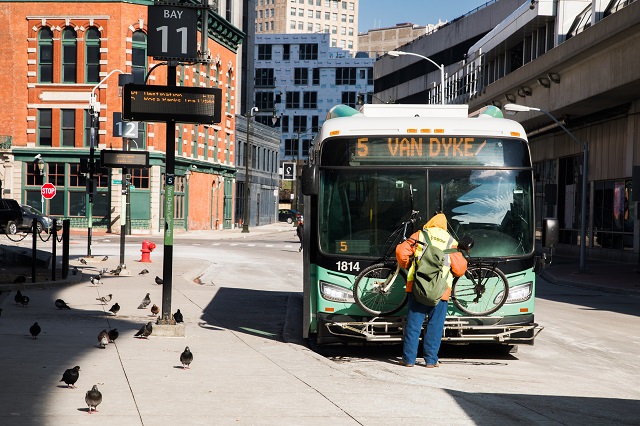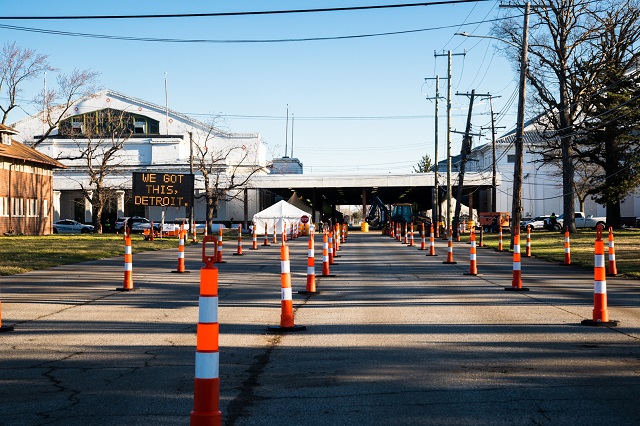
Disruption from COVID-19 could be the push transit agencies need to create more flexible, rapidly deployable solutions that improve mobility for marginalized communities. Photo by City of Detroit/Flickr
In less than two months, the COVID-19 pandemic has disrupted our lives, causing sickness, death, economic loss and fear. While this global health and safety crisis has been challenging for all of us, it has been especially tough for essential workers who rely on public transit to get to work.
As an embedded consultant with the City of Detroit’s Office of Mobility Innovation, I’ve communicated with over 100 essential workers in the past few months to understand how COVID-19 is impacting their commutes. Many wait for hours at night to catch a bus, or pile into crowded buses in the morning to get to work. As lockdowns lift in more places, transit agencies need to adapt and ensure all residents – especially Black and Latinx riders, who disproportionately rely on transit and are more likely to be exposed to and die from COVID-19 due to health disparities – can get to work and access the services they need safely.
A core pillar of most transit agencies is consistency and efficiency, which is a great asset in “normal” times. Success is measured by key performance indicators like on-time performance, ridership and passengers per vehicle per hour. Given how important their services are to millions of riders, transit agencies are also rightfully biased toward minimizing disruption and implementing changes thoughtfully and carefully through extensive community engagement processes. These attributes hold transit agencies accountable and build trust with riders. But in a public health crisis during which low ridership is actually preferred and shared trips present a significant risk, there is a need to react faster to keep up with the needs of residents.
So what can transit agencies do? The City of Detroit is working with NUMO, the New Urban Mobility alliance, to bring more flexible, more affordable mobility options to residents. The Office of Mobility Innovation is also working to understand our residents’ needs and seeking out ways to be more experimental while doing so.
1. Shift Mentality from Operational Excellence to Addressing Rider Concerns
Transit agencies must adjust their traditional mentality by asking how they can adequately help residents, especially those most vulnerable, move safely and affordably given the unique circumstances of the coronavirus.
Instead of operating under the assumption that transit agencies are limited to providing only traditional services like buses and trains, agencies should first consider what core transportation challenges residents face and then determine what types of solutions best fit those needs.
In my communications with essential workers in Detroit, many have said they do not feel safe taking the bus. Their core challenges are getting to and from work in a safe, affordable way. Many say they would prefer alternative forms of transportation that are different from traditional public transit.
There are many cities already responding to this need. Beijing launched new on-demand shuttle bus lines with carefully controlled occupancies, in addition to fixed-route services, specifically to help essential workers commute. In many cities across America, including Detroit, bike-sharing programs are free. These alternative options would be more strongly positioned as financially viable and reliable options in the long term if they were integrated with traditional public transit.
The shift in mentality required by transit agencies to adjust will not be easy. It requires both structural changes, to enable new partnerships between municipalities and the private sector, and cultural changes to reward experimentation and risk-taking.
2. Experiment and Try New Solutions
Right now, inaction is riskier than action. The status quo is not working, and every day of inaction results in increased risk of transmission and potential lives lost. This is the time to take risks and try new operating models. By failing to adapt, we are failing residents.

The City of Detroit is working with NUMO to test new mobility solutions for essential employees. Photo by City of Detroit/Flickr
When experimenting with new models and piloting new services, there will inevitably be challenges and risks. To mitigate risk, transit agencies should start small and initiate targeted pilot projects tailored to specific use cases. This helps test solutions and allows for iteration based on user feedback.
We at the City of Detroit, alongside NUMO, are using this approach to test new mobility solutions for essential employees. We started by reaching out to a few large essential employers from hospital systems to grocery stores. Then we surveyed employers and employees about transportation needs. From there, we were able to identify a range of new solutions for essential workers, from leasing subsidized e-bikes and scooters to credits for app-enabled ride-hailing or taxi services and on-demand shuttle services with controlled capacities. We embedded customer feedback loops into each stage, from ideating to piloting to scaling, to ensure we iterate services to meet customer needs.
Detroit is not alone in experimenting with new approaches. Indianapolis’ transit agency Indygo and the Pinellas Suncoast Transit Authority of Pinellas County, Florida, have piloted providing ride-hailing services for essential workers, and the Central Ohio Transit Authority and Central Contra Costa Transit Authority operating in the San Francisco Bay Area have piloted on-demand shuttle services. NUMO is helping to deploy e-bikes to essential workers in Bogotá, Colombia. As early results and lessons emerge, agencies should build upon these experiences, establish best practices and inspire each other to try new ways to meet resident needs.
3. Change Underlying Metrics of Success
Transit metrics tend to prioritize efficient operations over individual rider needs. Normally, the goal is to provide reliable services to as many people as possible. But as lockdowns lift, we face a new normal. Instead of optimizing for efficiency, we must optimize for safety and specific social and economic outcomes: Do residents feel safe? Are they able to get to jobs? Are they able to access critical services? If we shift metrics toward assessing quality of life outcomes, agencies will better serve residents. Such metrics would also do a better job highlighting how public transit is an essential service itself, the backbone of the economy and deserving of public funding.
To ensure these metrics have sticking power, however, we must foster a culture that encourages educated risk-taking and, most importantly, puts residents at the center of everything transit agencies do.
Change is not easy and can be especially difficult for transit agencies. While shifting culture, taking risks, and adjusting success metrics may be challenging initially, these changes have the potential to improve mobility for marginalized communities, increase access to economic opportunities and demonstrate how essential public transportation is for the world. The disruption from COVID-19 could in fact be the push that transit agencies need to shift their operating assumptions and create more flexible, rapidly deployable solutions designed to meet customer needs. Let’s not waste this opportunity to change; the lives and livelihoods of those in our communities are on the line.
Special thanks to OMI team members Hind Ourahou and Justin Snowden for their work on these initiatives, as well as Mark de la Vergne for his leadership.
Stacey Matlen is a Senior Mobility Strategist with the City of Detroit’s Office of Mobility Innovation.






